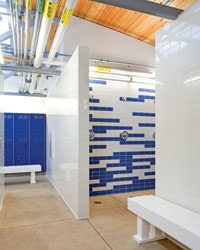With the ubiquity of LEED certification, today's locker rooms are filled with recycled and recyclable material
 Photo of the pool locker room at UCLA
Photo of the pool locker room at UCLAIn the locker room, the high-humidity place for showering, toilet visits and hand washing, sustainability is most often measured in terms of the efficiency of energy and water usage. On those fronts, low-flow fixtures with activation sensors or even solar thermal panels used to heat locker room water are just a couple flashier examples of the ways in which some of today's cutting-edge locker rooms are maximizing efficiency.
But take a look around a locker room, and even the most common components - partitions, countertops, benches and the lockers themselves - play some role in the greater movement toward sustainability. In fact, careful specification of such products has become critical in achieving credits toward LEED certification, or simply in adhering to the basic tenets of sustainability. To that end, manufacturers have responded with ever-increasing environmental sensitivity to provide a range of lockers and related hardware to suit the locker room.
The most noticeable advancement in green locker and partition products has been the widespread proliferation of plastic or other synthetic-based products that boast a high amount of post-consumer recycled content. By its nature as a metal, steel has always been valued as a recyclable material, and although some facility owners may prefer the natural durability and ease of maintenance associated with steel lockers, most operators of damp locker rooms now seek options that will, in the long term, be free from the prospect of corrosion.
Thus, numerous manufacturers offer lockers composed of recycled high-density polyethylene (HDPE) plastic in a range of sizes and colors. Although many lockers and partitions feature a post-consumer recycled content percentage in the 30 to 40 percent range, numerous manufacturers are now offering lockers composed of 100 percent recycled plastic, including at least one locker product composed entirely of recycled milk jugs.
Some manufacturers offer lockers composed of bamboo or agrifiber that qualify for a LEED credit because they may be considered "rapidly renewable materials," those that are harvested from plants that are typically harvested within a 10-year cycle. For lockers and partitions composed of wood - which are particularly popular in higher-end health club and professional and collegiate athletics settings - LEED points can be earned if at least 50 percent of the material is certified according to the standards of the Forest Stewardship Council.
Aside from recycled content, the other major environmental consideration when specifying lockers is air quality. For steel lockers, manufacturers have developed environmentally friendly powder coatings, reducing or eliminating the presence of volatile organic compounds (VOCs). To achieve certain LEED points related to air quality, lockers, partitions and other locker room furnishings should all meet the low-VOC-emissions specifications related to adhesives, sealants, paints, coatings, and composite woods and agrifibers.
Manufacturing processes or shipping distances notwithstanding, most providers of lockers and other locker room furnishings - many of which promote "green" products in their marketing materials - have continued to develop products that meet the latest sustainability standards. Thus, facility owners have more to choose from to meet not just their sustainability requirements, but their functionality and aesthetic desires, as well.




































